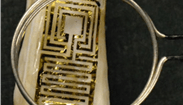Tooth Tattoo Tags Oral Bacteria
on

A new ultra-thin, flexible oral sensor dubbed ‘tooth tattoo’ jointly developed by Princeton University and Tufts researchers monitors mouth bacteria. Attached temporarily to a tooth, the sensor can measure bacteria levels in the mouth and could one day help dentists fine-tune treatments for patients with chronic periodontitis or provide an indication of the patient's overall health.
The sensor has a relatively simple structure with just three layers: a thin foil with gold electrodes, a monoatomic graphene layer, and a layer of specially engineered peptides, which are molecules that sense bacteria by binding to parts of their cell membranes. The researchers developed a new type of peptide that can act as an intermediary between bacteria and the sensor: one end bonds with the graphene, and the other bonds with bacteria, enabling the sensor to detect the presence of bacteria. Due to the fragility of the sensor layers, they must be mounted on a tough but flexible backing so they can be transferred to a tooth. The ideal material for this turned out to be silk.
As the sensor doesn't have any on-board power source, it must be read and powered simultaneously using a built-in antenna. A custom-made handheld device about the size of a TV remote control emits radio waves that ‘ping’ the sensor, causing it to resonate and send back information that can be used to determine the presence of bacteria.


Discussion (0 comments)